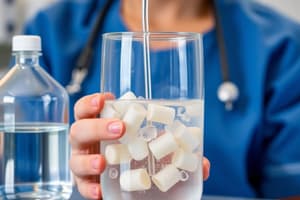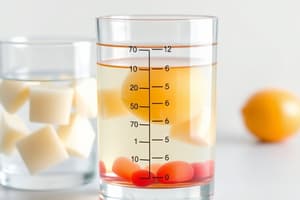Podcast
Questions and Answers
What is the approximate total body water volume in liters for a healthy, nonobese 70-kg male?
What is the approximate total body water volume in liters for a healthy, nonobese 70-kg male?
- 20 L
- 30 L
- 50 L
- 40 L (correct)
How does fat content affect total body water?
How does fat content affect total body water?
- Higher fat content leads to higher total body water.
- Fat content has no impact on total body water.
- Higher fat content leads to lower total body water. (correct)
- Higher fat content leads to a more stable total body water.
What is the approximate percentage of body weight attributed to water in a newborn infant?
What is the approximate percentage of body weight attributed to water in a newborn infant?
- 60%
- 40%
- 50%
- 80% (correct)
Which of the following factors contributes to the variation in total body water?
Which of the following factors contributes to the variation in total body water?
Which of the following is not a body fluid compartment?
Which of the following is not a body fluid compartment?
What is the underlying cause of water intoxication?
What is the underlying cause of water intoxication?
Which of these is NOT a characteristic of electrolytes?
Which of these is NOT a characteristic of electrolytes?
What is pitting edema?
What is pitting edema?
Which hormone plays a key role in restoring normal extracellular fluid volume?
Which hormone plays a key role in restoring normal extracellular fluid volume?
What is a cation?
What is a cation?
What is the main cause of hypernatremia?
What is the main cause of hypernatremia?
A patient presents with skeletal muscle weakness, paralysis, and cardiac arrest. Which electrolyte imbalance is most likely present?
A patient presents with skeletal muscle weakness, paralysis, and cardiac arrest. Which electrolyte imbalance is most likely present?
Which of the following conditions can cause hypocalcemia?
Which of the following conditions can cause hypocalcemia?
What is the primary symptom associated with both hypernatremia and hyponatremia?
What is the primary symptom associated with both hypernatremia and hyponatremia?
A patient with a history of prolonged diarrhea is suspected of having an electrolyte imbalance. Which electrolyte imbalance is most likely to be present?
A patient with a history of prolonged diarrhea is suspected of having an electrolyte imbalance. Which electrolyte imbalance is most likely to be present?
Which condition is characterized by increased neuromuscular irritability, including cramping, muscle twitching, and hyperactive reflexes?
Which condition is characterized by increased neuromuscular irritability, including cramping, muscle twitching, and hyperactive reflexes?
Which of the following is NOT a cause of hyperkalemia?
Which of the following is NOT a cause of hyperkalemia?
Which electrolyte imbalance is most commonly associated with the use of certain laxatives and diuretics?
Which electrolyte imbalance is most commonly associated with the use of certain laxatives and diuretics?
Which of the following statements accurately describes the role of antidiuretic hormone (ADH) in fluid balance?
Which of the following statements accurately describes the role of antidiuretic hormone (ADH) in fluid balance?
Which fluid compartment contains the largest volume of water in the human body?
Which fluid compartment contains the largest volume of water in the human body?
What is the primary function of aldosterone in regulating fluid balance?
What is the primary function of aldosterone in regulating fluid balance?
How does increased capillary blood pressure influence fluid movement in the body?
How does increased capillary blood pressure influence fluid movement in the body?
What is the primary source of metabolic water in the body?
What is the primary source of metabolic water in the body?
Which of the following is NOT a direct contributor to fluid output in the human body?
Which of the following is NOT a direct contributor to fluid output in the human body?
How does the body compensate for inadequate fluid intake when thirst sensation is not triggered?
How does the body compensate for inadequate fluid intake when thirst sensation is not triggered?
Which of the following statements best describes the concept of dehydration?
Which of the following statements best describes the concept of dehydration?
A patient's electrolyte panel reveals a potassium level of 6.2 mEq/L. Which EKG change would you most likely observe?
A patient's electrolyte panel reveals a potassium level of 6.2 mEq/L. Which EKG change would you most likely observe?
Which of the following conditions is most likely to cause the EKG abnormality of a flattened or prolonged ST segment?
Which of the following conditions is most likely to cause the EKG abnormality of a flattened or prolonged ST segment?
A patient undergoing a blood transfusion develops hypocalcemia. What is the most likely cause of this electrolyte imbalance in this scenario?
A patient undergoing a blood transfusion develops hypocalcemia. What is the most likely cause of this electrolyte imbalance in this scenario?
Which EKG change is most closely associated with hypokalemia?
Which EKG change is most closely associated with hypokalemia?
A patient with a history of bone tumors is admitted. Which electrolyte imbalance is the patient most at risk for?
A patient with a history of bone tumors is admitted. Which electrolyte imbalance is the patient most at risk for?
Which of the following electrolyte imbalances is most likely associated with a widened QRS complex on an EKG?
Which of the following electrolyte imbalances is most likely associated with a widened QRS complex on an EKG?
A patient presents with increased cardiac contractility and a very short ST segment on their EKG. Which electrolyte imbalance is most likely?
A patient presents with increased cardiac contractility and a very short ST segment on their EKG. Which electrolyte imbalance is most likely?
A patient is diagnosed with rhabdomyolysis. Which electrolyte imbalance is most likely to occur as a direct result of this condition?
A patient is diagnosed with rhabdomyolysis. Which electrolyte imbalance is most likely to occur as a direct result of this condition?
A patient's serum sodium level is reported as 150 mEq/L. Which of the following conditions is the patient most likely experiencing?
A patient's serum sodium level is reported as 150 mEq/L. Which of the following conditions is the patient most likely experiencing?
Which of the following physiological processes is directly dependent on sodium ions?
Which of the following physiological processes is directly dependent on sodium ions?
If a patient is diagnosed with hyponatremia, which of the following would be the expected serum sodium level?
If a patient is diagnosed with hyponatremia, which of the following would be the expected serum sodium level?
The kidneys play a crucial role in maintaining sodium balance in the body. How do the kidneys primarily regulate sodium levels?
The kidneys play a crucial role in maintaining sodium balance in the body. How do the kidneys primarily regulate sodium levels?
How does sodium contribute to the regulation of fluid balance in the body?
How does sodium contribute to the regulation of fluid balance in the body?
Flashcards
Body Fluid Volume Variation
Body Fluid Volume Variation
Total body water varies by weight, fat, gender, and age.
Body Fluid Compartments
Body Fluid Compartments
Body fluids are divided into plasma, interstitial fluid, and intracellular fluid.
Fluid Balance Mechanisms
Fluid Balance Mechanisms
The body uses several mechanisms to maintain fluid balance.
Electrolyte Importance
Electrolyte Importance
Signup and view all the flashcards
Common Fluid Imbalances
Common Fluid Imbalances
Signup and view all the flashcards
Overhydration
Overhydration
Signup and view all the flashcards
Water intoxication
Water intoxication
Signup and view all the flashcards
Electrolytes
Electrolytes
Signup and view all the flashcards
Cations
Cations
Signup and view all the flashcards
Pitting edema
Pitting edema
Signup and view all the flashcards
Electrolyte Imbalance
Electrolyte Imbalance
Signup and view all the flashcards
Hypernatremia
Hypernatremia
Signup and view all the flashcards
Hyponatremia
Hyponatremia
Signup and view all the flashcards
Hyperkalemia
Hyperkalemia
Signup and view all the flashcards
Hypokalemia
Hypokalemia
Signup and view all the flashcards
Hypercalcemia
Hypercalcemia
Signup and view all the flashcards
Hypocalcemia
Hypocalcemia
Signup and view all the flashcards
CNS Symptoms of Sodium Imbalances
CNS Symptoms of Sodium Imbalances
Signup and view all the flashcards
Extracellular Fluid (ECF)
Extracellular Fluid (ECF)
Signup and view all the flashcards
Intracellular Fluid (ICF)
Intracellular Fluid (ICF)
Signup and view all the flashcards
Fluid Intake Sources
Fluid Intake Sources
Signup and view all the flashcards
Fluid Output Sources
Fluid Output Sources
Signup and view all the flashcards
Antidiuretic Hormone (ADH)
Antidiuretic Hormone (ADH)
Signup and view all the flashcards
Fluid Imbalance - Dehydration
Fluid Imbalance - Dehydration
Signup and view all the flashcards
Capillary Blood Pressure Effects
Capillary Blood Pressure Effects
Signup and view all the flashcards
Regulation of Fluid Intake
Regulation of Fluid Intake
Signup and view all the flashcards
Ion
Ion
Signup and view all the flashcards
Anion
Anion
Signup and view all the flashcards
Normal Sodium (Na+) Level
Normal Sodium (Na+) Level
Signup and view all the flashcards
Sodium's Location
Sodium's Location
Signup and view all the flashcards
Sodium's Role
Sodium's Role
Signup and view all the flashcards
Study Notes
Sodium (Na+)
- Normal sodium levels are 135-145 mEq/L.
- Sodium levels are inversely related to potassium levels.
- Sodium is the main cation of extracellular fluid (ECF).
- The kidneys regulate sodium.
- Sodium is essential in regulating water of both intracellular (ICF) and extracellular fluid (ECF).
- Sodium is necessary for nerve function, muscle contraction, and regulating acid-base balance.
- Hyponatremia is the most common electrolyte disorder.
Hypernatremia (>145 mEq/L)
- Characterized by "HIGH" sodium levels.
- Causes consist of inadequate water intake, fever, excessive sweating, diarrhea, diabetes insipidus, excess sodium intake (IV fluids), and decreased renal sodium excretion.
- Signs and symptoms include extreme thirst, agitation, confusion, seizures, coma, fluid retention, dry flushed skin, and muscle twitches with contractions.
- Restrict sodium and fluid intake as ordered for management.
- Treat water loss with IV fluids.
- Treat decreased sodium excretion with diuretics that promote sodium loss.
Hyponatremia (<135 mEq/L)
- Characterized by "LOW" sodium levels.
- Inadequate sodium intake, dilution of serum sodium (excessive hypotonic fluids, kidney disease, SIADH, heart failure), and increased sodium excretion (excessive sweating, diuretics, vomiting, diarrhea, wound drainage) contribute to this deficit.
- Signs and symptoms include headache, confusion, seizures, coma, nausea, cramping with diarrhea, muscle weakness, and decreased urinary output.
- Manage fluid deficits (hypovolemia) with sodium chloride IV, and fluid overload (hypervolemia) with diuretics as prescribed.
- Increased oral sodium intake as well as monitoring lithium levels due to the potential for lithium toxicity are other facets of treatment.
- Increasing sodium levels too quickly can cause permanent brain damage.
Studying That Suits You
Use AI to generate personalized quizzes and flashcards to suit your learning preferences.




